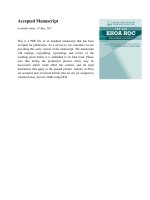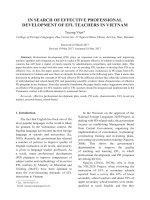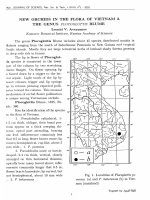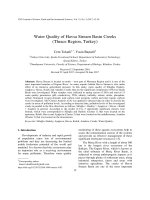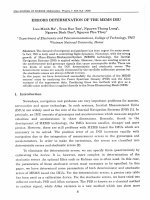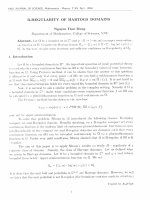DSpace at VNU: New inequalities of Ostrowski-like type involving n knots and the L-p-norm of the m-th derivative
Bạn đang xem bản rút gọn của tài liệu. Xem và tải ngay bản đầy đủ của tài liệu tại đây (375.2 KB, 6 trang )
Applied Mathematics Letters 22 (2009) 1345–1350
Contents lists available at ScienceDirect
Applied Mathematics Letters
journal homepage: www.elsevier.com/locate/aml
New inequalities of Ostrowski-like type involving n knots and the
Lp -norm of the m-th derivative
Vu Nhat Huy a , Quô´c-Anh Ngô a,b,∗
a
Department of Mathematics, College of Science, Viêt Nam National University, Hà Nôi, Viêt Nam
b
Department of Mathematics, National University of Singapore, 2 Science Drive 2, Singapore 117543, Singapore
article
abstract
info
Article history:
Received 23 April 2008
Received in revised form 3 March 2009
Accepted 30 March 2009
On the basis of recent results due to Nenad Ujević, we obtain some new inequalities of
Ostrowski-like type involving n knots and the Lp -norm of the m-th derivative where n, m,
p are arbitrary numbers.
© 2009 Elsevier Ltd. All rights reserved.
Keywords:
Inequality
Error
Integral
Taylor
Ostrowski
1. Introduction
In recent years, a number of authors have considered error inequalities for some known and some new quadrature
formulas. Sometimes they have considered generalizations of these formulas; see [1,2] and the references therein where
the mid-point and trapezoid quadrature rules are considered.
This work is motivated by some results due to Nenad Ujević. Here we recall them.
Theorem 1 (See [1]). Let I ⊂ R be an open interval such that [a, b] ⊂ I and let f : I → R be a twice-differentiable function
such that f is bounded and integrable. Then we have
b
f (x)dx −
b−a
2
a
+f
a+b
2
f
a+b
2
√
− 2−
3 ( b − a)
√
√
+ 2−
7−4 3
3 (b − a)
8
f
∞
( b − a) 3 .
(1)
Theorem 2 (See [2]). Let I ⊂ R be an open interval such that [a, b] ⊂ I and let f : I → R be a twice-differentiable function
such that f ∈ L2 (a, b). Then we have
√
b
f (x)dx −
a
∗
b−a
2
f
a+b
2
−
3−
2
6
(b − a)
Corresponding author at: Department of Mathematics, College of Science, Viêt Nam National University, Hà Nôi, Viêt Nam.
E-mail addresses: (V.N. Huy), (Q.-A. Ngô).
0893-9659/$ – see front matter © 2009 Elsevier Ltd. All rights reserved.
doi:10.1016/j.aml.2009.03.002
1346
V.N. Huy, Q.-A. Ngô / Applied Mathematics Letters 22 (2009) 1345–1350
√
a+b
+f
2
+
3−
6
49
(b − a)
2
80
1√
6 f
4
−
5
2
( b − a) 2 .
√
In the above mentioned results, constants 7−48
3
49
80
in (1) and
−
1
4
(2)
√
6 in (2) are sharp in the sense that these cannot
be replaced by smaller ones. This leads us to strengthen (1) and (2) by enlarging the number of knots (two knots in both (1)
and (2)) and replacing the norms · ∞ in (1) and · 2 in (2).
Before stating our main result, let us introduce the following notation.
b
f (x)dx.
I (f ) =
a
Let 1
m, n < ∞ and 1 p ∞. For each i = 1, n, we assume 0 < xi < 1 such that
n
x1 + x2 + · · · + xn = ,
2
· · ·
n
j
j
x1 + x2 + · · · + xnj =
,
j
+
1
·
·
·
xm−1 + xm−1 + · · · + xm−1 = n .
n
1
2
m
Put
Q (f , n, m, x1 , . . . , xn ) =
n
b−a
f (a + xi (b − a)) .
n
i=1
Remark 3. With the above notation, (1) reads as follows:
I (f ) − Q
f , 2, 2,
1
2
√
1
3 ,
− 2−
2
√
√
+ 2−
7−4 3
3
8
f
∞
(b − a)3
(3)
while (2) reads as follows:
√
I (f ) − Q
f , 2, 2,
1
2
−
3−
√
6 1
2
,
2
+
3−
6
49
2
80
−
1√
4
6 f
5
2
( b − a) 2 .
(4)
We are in a position to state our main result.
Theorem 4. Let I ⊂ R be an open interval such that [a, b] ⊂ I and let f : I → R be an m-times-differentiable function such
that f (m) ∈ Lp (a, b). Then we have
|I (f ) − Q (f , n, m, x1 , . . . , xn )|
1
1
m!
mq + 1
1
q
+
1
(m − 1) q + 1
1
q
f (m)
1
p
(b − a)m+ q
(5)
where
1
p
+
1
q
=1
and
f
r
:=
b
|f (x)| dx
a
ess sup |f |,
r
[a,b]
1
r
,
when 1 ≤ r < ∞,
when r = ∞.
Remark 5. It is worth noticing that the right hand side of (5) does not involve xi , i = 1, n, and that m can be chosen arbitrarily.
This means that our inequality (5) is better in some sense. However, the inequality (5) is not sharp due to the restriction of
the technique that we use. We hope that we will soon see some responses on this problem.
V.N. Huy, Q.-A. Ngô / Applied Mathematics Letters 22 (2009) 1345–1350
1347
2. Proofs
Before proving our main theorem, we need an essential lemma below. It is well-known in the literature as Taylor’s
formula or Taylor’s theorem with the integral remainder.
Lemma 6 (See [3]). Let f : [a, b] → R and let r be a positive integer. If f is such that f (r −1) is absolutely continuous on [a, b],
x0 ∈ (a, b), then for all x ∈ (a, b) we have
f (x) = Tr −1 (f , x0 , x) + Rr −1 (f , x0 , x)
where Tr −1 (f , x0 , ·) is Taylor’s polynomial of degree r − 1, that is,
r −1
Tr −1 (f , x0 , x) =
f (k) (x0 ) (x − x0 )k
k!
k=0
and the remainder can be given by
x
Rr −1 (f , x0 , x) =
x0
(x − t )r −1 f (r ) (t )
dt .
(r − 1)!
(6)
By a simple calculation, the remainder in (6) can be rewritten as
x −x 0
Rr −1 (f , x0 , x) =
0
(x − x0 − t )r −1 f (r ) (x0 + t )
dt
(r − 1)!
which helps us to deduce a similar representation of f as follows:
r −1
f ( x + u) =
uk (k)
f (x) +
k!
k=0
u
0
(u − t )r −1 (r )
f (x + t ) dt .
(r − 1)!
(7)
Proof of Theorem 4. Define
x
F (x) =
f (x)dx.
a
By the Fundamental Theorem of Calculus
I (f ) = F (b) − F (a) .
Applying Lemma 6 to F (x) with x = a and u = b − a, we get
m
F (b) = F (a) +
k=1
(b − a)k (k)
F ( a) +
k!
b−a
0
(b − a − t )m (m+1)
F
(a + t ) dt
m!
which yields
(b − a)k (k)
F (a) +
k!
m
I (f ) =
k=1
b−a
0
(b − a − t )m (m+1)
F
(a + t ) dt .
m!
Equivalently,
m−1
I (f ) =
k=0
For each 1
i
(b − a)k+1 (k)
f (a) +
(k + 1)!
b−a
0
(b − a − t )m (m)
f
(a + t ) dt .
m!
n, applying Lemma 6 to f (x) with x = a and u = xi (b − a), we get
xki (b − a)k (k)
f (a) +
k!
k=0
xi (b−a)
m−1
f (a + xi (b − a)) =
xki (b − a)k (k)
f (a) +
k!
k=0
0
m−1
=
b−a
0
(xi (b − a) − t )m−1 (m)
f
(a + t ) dt
(m − 1)!
m−1
xm
i ( b − a − u)
f (m) (a + xi u) du.
(m − 1)!
(8)
1348
V.N. Huy, Q.-A. Ngô / Applied Mathematics Letters 22 (2009) 1345–1350
By applying (8) to i = 1, n and then summing, we deduce that
xki (b − a)k (k)
f (a) +
k!
i=1 k=0
i=1
m−1
n
n
f (a + xi (b − a)) =
i=1
n
n
xki (b − a)k
m−1
i=1
=
k!
k=0
0
n
f (k) (a) +
n (b − a)k (k)
f (a) +
(k + 1)!
k=0
i =1
n
0
b−a
0
m−1
xm
i (b − a − u)
f (m) (a + xi u) du
(m − 1)!
m−1
xm
i ( b − a − u)
f (m) (a + xi u) du
(m − 1)!
b −a
i =1
m−1
=
b−a
m−1
xm
i ( b − a − u)
f (m) (a + xi u) du.
(m − 1)!
(9)
Thus,
m−1
Q (f , n, m, x1 , . . . , xn ) =
k=0
b−a
(b − a)k+1 (k)
f ( a) +
n
(k + 1)!
n
b−a
0
i =1
m−1
xm
i ( b − a − u)
f (m) (a + xi u) du.
(m − 1)!
Therefore,
|I (f ) − Q (f , n, m, x1 , . . . , xn )|
b−a
b−a
(b − a − t )m (m)
f
(a + t ) dt −
m!
n
b−a
b−a
(b − a − t ) (m)
f
(a + t ) dt +
m!
n
=
0
0
b
=
a
n
b−a
(b − x) (m)
f (x)dx +
m!
n
n
(b − ·) (m)
f
m!
m
+
n
n
1
a
b −a
0
i=1
xm
i
m−1
xm
i ( b − a − u)
f (m) (a + xi u) du
(m − 1)!
m−1
xm
i (b − a − u)
f (m) (a + xi u) du
(m − 1)!
(b − x)m−1 (m)
f
((1 − xi ) a + xi x) dx
(m − 1)!
(b − ·)m−1 (m)
f
((1 − xi ) a + xi ·)
(m − 1)!
n
b−a
i=1
b
0
i =1
m
m
b−a
xm
i
i=1
.
1
Using the Hölder inequality, we get
(b − ·)m (m)
f
m!
=
1
1
(b − ·) f
m
m!
1
We see that f (m) ((1 − xi ) a + xi ·) ∞
f
(m)
p
=
f
m!
(m)
(b − ·)
p
f (m) ∞ while, for 1
b
((1 − xi ) a + xi ·)
1
(m)
f
(m)
m
q
=
1
m!
(b − a)mq+1
mq + 1
p < ∞, we have
p
((1 − xi ) a + xi x) dx
1
p
a
=
1
p
xi
=
b
1
f
1
p
1
p
=
1
1
p
1
f (m) (t )
a
b
f
(m)
a
f (m)
p
xi
xi
((1 − xi ) a + xi x) d ((1 − xi ) a + xi x)
(1−xi )a+xi b
1
xi
p
a
1
xi
(m)
f (m)
p
.
p
(t ) dt
1
p
p
1
p
dt
1
p
1
q
f (m)
p
.
(10)
V.N. Huy, Q.-A. Ngô / Applied Mathematics Letters 22 (2009) 1345–1350
1349
This helps us to deduce that
n
m−1
xm
i (b − ·)
f (m) ((1 − xi )a + xi ·)
(m − 1)!
n
b−a
i=1
=
n
b−a
n
n
n
n
i =1
n
xm
i
f (m)
(m − 1)!
xi
−1
xm
i
i =1
f (m)
f (m)
n
b−a
f (m) ((1 − xi ) a + xi ·)
(m − 1)!
n
b−a
=
xm
i
i =1
(m − 1)!
1
q
m!
q
1
q
1
q
(b − a)(m−1)q+1
(m − 1) q + 1
p
1
(b − ·)(m−1)
p
(b − a)(m−1)q+1
(m − 1) q + 1
p
(b − a)mq+1
(m − 1) q + 1
p
1
(b − ·)m−1 f (m) ((1 − xi ) a + xi ·)
(m − 1)!
i =1
b−a
=
xm
i
.
It follows that
1
q
(b − a)mq+1
mq + 1
1
|I (f ) − Q (f , n, m, x1 , . . . , xn )|
m!
f
f (m)
(m)
p
+
p
m!
(b − a)mq+1
(m − 1) q + 1
1
q
which completes our proof.
3. Examples
In this section, by applying our main theorem, we will obtain some new inequalities which cannot be easily obtained
from [1,2].
Example 7. When n = 3, m = 3 and
√
0<
1
4
21
−
12
√
1
<
x1
1
<
2
+
4
x2
21
12
<1
(11)
x3
we deduce that
√
b
f (x)dx −
a
b−a
a+
f
3
1
4
−
21
12
√
√
+f
a+
1
4
+
(b − a) + f
21
1
2
(b − a)
√
7+
(b − a)
12
a+
√
5
6 35
7
f
2
(b − a) 2 .
(12)
Example 8. When n = 2, m = 3 and
0<
1
2
1
1
2 3
2
− √ <
x1
1
− √ <1
(13)
2 3
x2
we deduce that
b
f (x)dx −
a
b−a
2
f
a+b
2
1
a+b
2 3
2
− √ (b − a) + f
1
7
2 3
72
+ √ ( b − a)
f
∞
(b − a)4 .
(14)
1350
V.N. Huy, Q.-A. Ngô / Applied Mathematics Letters 22 (2009) 1345–1350
Example 9. When m = 2 and 0 < xi < 1 such that
b
f (x)dx −
a
b−a
n
n
f (a + xi (b − a))
i=1
n
i =1
5
12
xi =
f
∞
n
2
then we have
(b − a)3 ,
(15)
and
b
f (x)dx −
a
b−a
n
5+
f (a + xi (b − a))
f (x)dx −
a
b−a
2 15
i=1
n
n
f (a + xi (b − a))
i=1
3
√
Example 10. When m = 3 and 0 < xi < 1 such that
b
√
√
n
n
i =1
7
72
f
xi =
5
f
2
n
2
∞ (b
( b − a) 2 .
and
n
i=1
x2i =
(16)
n
3
then we have
− a)4 .
(17)
Acknowledgments
The authors would like to express sincere gratitude to the two anonymous referees for their constructive suggestions on
the manuscript.
References
[1] N. Ujević, Error inequalities for a quadrature formula of open type, Rev. Colombiana Mat. 37 (2003) 93–105.
[2] N. Ujević, Error inequalities for a quadrature formula and applications, Comput. Math. Appl. 48 (2004) 1531–1540.
[3] G.A. Anastassiou, S.S. Dragomir, On some estimates of the remainder in Taylor’s formula, J. Math. Anal. Appl. 263 (2001) 246–263.


